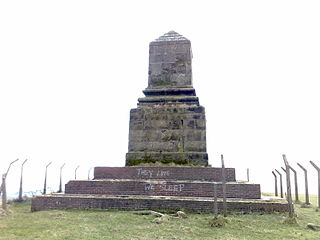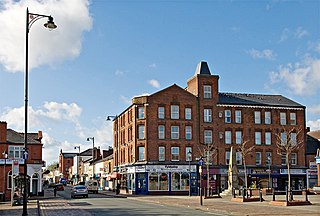
Saffron Walden is a market town in the Uttlesford district of Essex, England, 12 miles (19 km) north of Bishop's Stortford, 15 miles (24 km) south of Cambridge and 43 miles (69 km) north of London. It retains a rural appearance and some buildings of the medieval period. The population was 15,504 at the 2011 census.

Maltby is a former mining town and civil parish in the Metropolitan Borough of Rotherham, South Yorkshire, England. It was historically in the West Riding of Yorkshire. It is located 6 miles (10 km) east of Rotherham and 10 miles (16 km) north-east of Sheffield. It forms a continuous urban area with Hellaby, separated from the rest of Rotherham by the M18 motorway. It had a population of 16,688 at the 2011 Census.

Rossington is a civil parish and former mining village in the Metropolitan Borough of Doncaster in South Yorkshire, England and is surrounded by countryside and the market towns of Bawtry and Tickhill.

Gleadless is a suburb and parish within the City of Sheffield, it lies five km south east of the city centre. It is bordered by the adjoining suburbs of Gleadless Valley to the west, Frecheville to the east and Intake to the north. The land to the south is the rural area of North East Derbyshire district which is outside the city boundary. Gleadless was formerly a country hamlet, then village before becoming part of the expanding city of Sheffield in 1921. The word Gleadless comes from the Old English language and means either "forest clearings haunted by a kite" or "bright clearing".
Audley Rural is a parish of Staffordshire, England, located four miles to the north-west of the town of Newcastle-under-Lyme. It is predominantly a rural area, of which Audley is the centre. Other settlements are Alsagers Bank, Bignall End, Halmer End, Miles Green, Scot Hay and Wood Lane, and the outlying hamlets of Dunkirk, Mill End, Shraley Brook, Eardley End, Coopers Green, Butters Green and Crackley Gates. The population of this parish at the 2011 census was 8,437.

Bignall Hill, Staffordshire is a local landmark, and forms part of an escarpment ridge 4 miles (6.4 km) north-west of Newcastle-under-Lyme. It is classed as a sub HuMP. There is a large stone monument on the summit which is dedicated to John Wedgwood (1760–1839), a former local employer and coal mine owner. Wedgwood's monument was initially an obelisk erected in 1850. Following storm damage in 1976 it was reduced to a quarter of its original size, although the base is still substantial. The monument is a Grade II listed building. The monument is today reachable by footpaths, and is the highest point in the area. It affords sweeping 360-degree views: south to Cannock Chase and the city of Stoke-on-Trent; north across the Cheshire Plains to Jodrell Bank radio telescope; east to Mow Cop Castle and the Peak District; and west to the mountains of North Wales and Snowdonia.

Astley is a village in the Metropolitan Borough of Wigan, Greater Manchester, England. Within the boundaries of the historic county of Lancashire, it is crossed by the Bridgewater Canal and the A580 East Lancashire Road. Continuous with Tyldesley, it is between Wigan and Manchester, both 8 miles (13 km) away. Astley Mosley Common ward had a population of 11,270 at the 2011 Census.

Tyldesley is a market town in Metropolitan Borough of Wigan in Greater Manchester, England. Within the boundaries of the historic county of Lancashire, it is north of Chat Moss near the foothills of the West Pennine Moors, 8 miles (12.9 km) southeast of Wigan and 9 miles (14.5 km) northwest of Manchester. At the United Kingdom Census 2001, the Tyldesley built-up area subdivision, excluding Shakerley, had a population of 16,142.

Blagdon is a village and civil parish in the ceremonial county of Somerset, within the unitary authority of North Somerset, in England. It is located in the Mendip Hills, a recognised Area of Outstanding Natural Beauty. According to the 2011 census it has a population of 1,116. The village is about 12 miles (19 km) east of Weston-super-Mare on the A368 between Churchill and Compton Martin.

Audley is a large village and former civil parish, now in the parish of Audley Rural, in the Newcastle-under-Lyme district, in Staffordshire, England. It is the centre of Audley Rural parish, approximately four miles north west of Newcastle-under-Lyme and 3 miles from Alsager near the Staffordshire-Cheshire border.

Netherton is a village in the City of Wakefield metropolitan borough of West Yorkshire, England. It lies about 4 miles south-west of Wakefield, 3 miles south of Ossett and 1 mile south of Horbury. The village is in the Wakefield Rural ward of Wakefield Metropolitan District Council. The village name is shown on map "Dvcatvs Eboracensis pars occidentalis" from 1646.
Ellistown is a village about 2 miles (3 km) south of Coalville in North West Leicestershire, England. It is named after Colonel Joseph Joel Ellis who died in 1885. The population from the 2011 census was included in the civil parish of Ellistown and Battleflat.
Leycett was a small mining village in Staffordshire in the Borough of Newcastle-under-Lyme which was built in the late eighteen sixties to accommodate the miners and their families. Population details as taken at the 2011 census can be found under Madeley with the name Leycett meaning 'the clearing in the woods'.
Audley and Bignall End was a ward in the Borough of Newcastle-under-Lyme, in the county of Staffordshire, England. It covered the villages of Audley and Bignall End. According to the 2011 Census it had a population of 5,927. In 2018 it was combined with part of Halmerend to form Audley ward.
Nicholas Colin Bignall is an English semi-professional footballer who plays as a forward. A product of the Reading academy, he played on loan for a number of Football League clubs before recurring injuries forced him to drop into non-League football.

Chell is a suburb of the city of Stoke-on-Trent in the ceremonial county of Staffordshire, England, that can be subdivided into Little Chell, Great Chell and Chell Heath. It lies on the northern edge of the city, approximately 1-mile (1.6 km) from Tunstall, 2 miles (3.2 km) from Burslem and 3 miles (4.8 km) from the county border with Cheshire. Chell borders Pitts Hill to the west, Tunstall to the south west, Stanfield and Bradeley to the south, with the outlying villages of Packmoor and Brindley Ford to the north and Ball Green to the east. Since 2011 the area has been divided into the electoral wards of Bradeley & Chell Heath, Great Chell & Packmoor and Little Chell & Stanfield.
Red Street is a small, semi-rural village in the borough of Newcastle-under-Lyme, Staffordshire 6 miles (9.7 km) north west of Stoke-on-Trent, 2 miles (3.2 km) east of the neighbouring village of Audley and 1 mile (1.7 km) north of Chesterton.

The Stoke-on-Trent Green Belt is a green belt environmental and planning policy that regulates the rural space throughout mainly the West Midlands region of England. It is contained within the counties of Cheshire and Staffordshire. Essentially, the function of the designated area is to prevent surrounding towns and villages within the Stoke-on-Trent conurbation from further convergence. It is managed by local planning authorities on guidance from central government.
Audley Rural is a civil parish in the district of Newcastle-under-Lyme, Staffordshire, England. It contains 14 buildings that are recorded in the National Heritage List for England. Of these, one is listed at Grade II*, the middle of the three grades, and the others are at Grade II, the lowest grade. The parish contains villages, including Audley and Bignall End, and is otherwise rural. Most of the listed buildings are farmhouses, and the other listed buildings include a church, two watermills, a milepost, a memorial on a hill, a row of houses and shops, a church hall, and two war memorials.
The Diglake Colliery Disaster, was a coal-mining disaster at what was Audley Colliery in Bignall End, North Staffordshire, on 14 January 1895. A flood of water rushed into the mine and caused the deaths of 77 miners. Only three bodies were recovered, with efforts to retrieve the dead hampered by floodwater. 73 bodies are still entombed underground.













